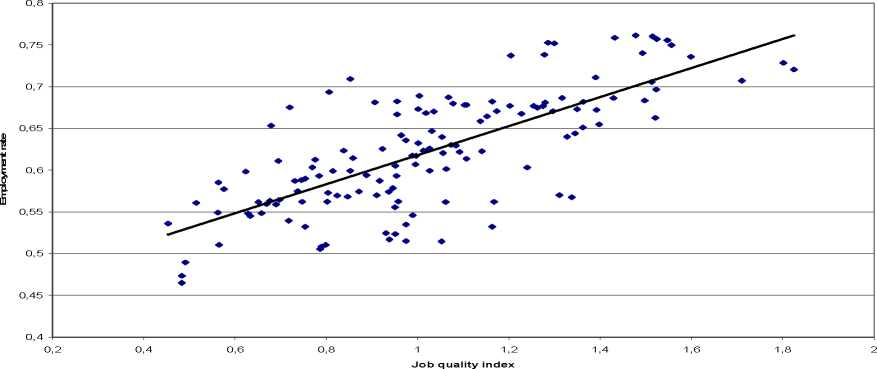8 | Erhel & Guergoat-Larivière
cycle, as well with a small differential between male and female employment rates. The
correlation rate with the synthetic job quality index that was constructed in a previous study
(Davoine, Erhel, Guergoat-Larivière, 2008a; European Commission, 2008) is also positive and
high, as confirmed by Figure 5.
hal-00616771, version 1 - 24 Aug 2011
Table 2. Correlations between quality indicators and the employment rate for EU countries,
1983-2004
|
Correlation with employment rate | |
|
Training rate________________________________________________________ |
0.67 |
|
Part-time rate___________________________________________________________ |
0.59 |
|
Temporary employment rate___________________________________ |
0.03 |
|
Long-term unemployment rate_________________________________ |
-0.14 |
|
Percentage of the population achieving secondary level education |
0.45 |
|
Shift work rate_______________________________________________________ |
0.02 |
|
Evening work rate______________________________________________ |
0.07 |
|
Night work rate___________________________________________________ |
0.25 |
|
Saturday work rate________________________________________________ |
-0.44 |
|
Sunday work rate______________________________________________ |
0.33 |
|
Occupational segregation__________________________________________ |
0.40 |
|
Senior employment gap_______________________________________ |
0.13 |
|
Gender employment gap______________________________________ |
0.77 |
|
Employment quality index______________________________________ |
0.74 |
Source: Davoine, Erhel, Guergoat-Larivière (2008a), LFS 1983-2004, authors’ calculations,
138 observations (one observation corresponds to one year for a given country; annual data,
number of countries included depending on data availability, 6 in 1983 to 21 in 2004).
Figure 5. Job quality index and employment rates, EU countries, 1983-2004

Source: LFS 1983-2004, authors’ calculations; one observation corresponds to one year for a given country.
The job quality index is also related to other labour market indicators, like the unemployment
rate. We provide two figures representing the relationship with long-term unemployment
(Figure 6) and with the NAIRU (Figure 7). A higher level of job quality is associated with lower
long-term unemployment and a lower NAIRU.
More intriguing information
1. The Impact of Hosting a Major Sport Event on the South African Economy2. The Macroeconomic Determinants of Volatility in Precious Metals Markets
3. ENVIRONMENTAL POLICY: THE LEGISLATIVE AND REGULATORY AGENDA
4. The Role of area-yield crop insurance program face to the Mid-term Review of Common Agricultural Policy
5. The Cost of Food Safety Technologies in the Meat and Poultry Industries.
6. The name is absent
7. The name is absent
8. EMU's Decentralized System of Fiscal Policy
9. The name is absent
10. The name is absent